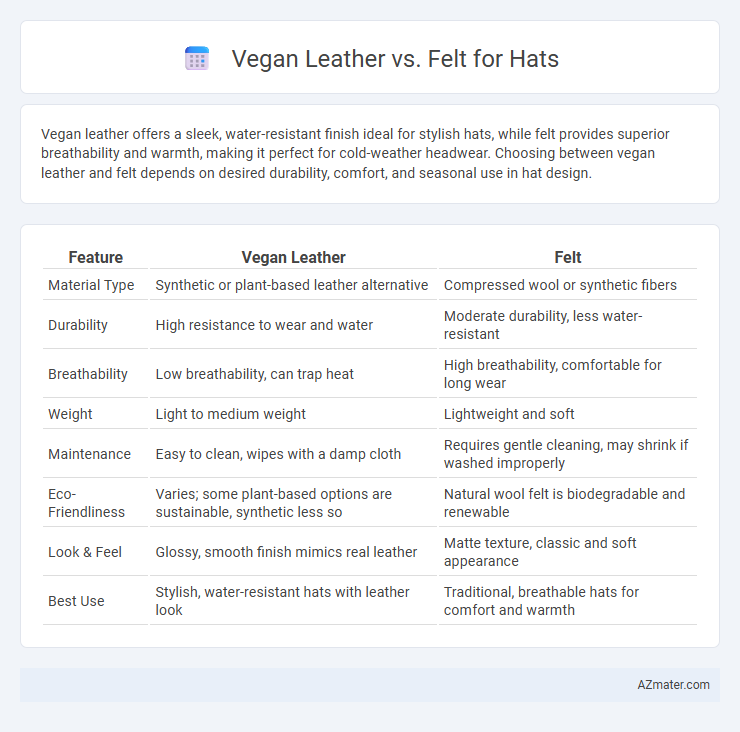Vegan leather offers a sleek, water-resistant finish ideal for stylish hats, while felt provides superior breathability and warmth, making it perfect for cold-weather headwear. Choosing between vegan leather and felt depends on desired durability, comfort, and seasonal use in hat design.
Table of Comparison
| Feature | Vegan Leather | Felt |
|---|---|---|
| Material Type | Synthetic or plant-based leather alternative | Compressed wool or synthetic fibers |
| Durability | High resistance to wear and water | Moderate durability, less water-resistant |
| Breathability | Low breathability, can trap heat | High breathability, comfortable for long wear |
| Weight | Light to medium weight | Lightweight and soft |
| Maintenance | Easy to clean, wipes with a damp cloth | Requires gentle cleaning, may shrink if washed improperly |
| Eco-Friendliness | Varies; some plant-based options are sustainable, synthetic less so | Natural wool felt is biodegradable and renewable |
| Look & Feel | Glossy, smooth finish mimics real leather | Matte texture, classic and soft appearance |
| Best Use | Stylish, water-resistant hats with leather look | Traditional, breathable hats for comfort and warmth |
Introduction to Vegan Leather and Felt Hats
Vegan leather, crafted from synthetic or plant-based materials, offers a cruelty-free and durable alternative to traditional leather, making it a popular choice for modern hats with a sleek, leather-like appearance. Felt, made from compressed natural fibers like wool or synthetic blends, provides a soft, warm texture and excellent form-retention, ideal for classic and stylish hat designs. Choosing between vegan leather and felt depends on preferences for material sustainability, texture, and hat style versatility.
Material Origins: Vegan Leather vs Felt
Vegan leather is a synthetic material derived from polyurethane or plant-based sources like cork and pineapple leaves, offering a cruelty-free alternative to traditional animal leather. Felt is crafted from natural fibers such as wool, alpaca, or synthetic fibers, formed through a process of matting and compressing fibers together. Both materials vary significantly in their origins, with vegan leather emphasizing ethical production and felt highlighting natural or blended fiber composition.
Environmental Impact and Sustainability
Vegan leather, often made from polyurethane or plant-based materials like pineapple leaves, offers a cruelty-free alternative to traditional leather but can vary in environmental impact based on production methods, with some contributing to plastic waste and chemical pollution. Felt, typically crafted from natural fibers such as wool or recycled textiles, is biodegradable and generally has a lower carbon footprint, supporting sustainable practices through renewable resource use and minimal chemical processing. Choosing felt for hats promotes sustainability by reducing synthetic material reliance, while vegan leather options require careful sourcing to ensure eco-friendly credentials.
Durability and Longevity Comparison
Vegan leather offers superior durability compared to felt, featuring resistance to water, scratches, and daily wear, making it ideal for long-term use. Felt, while breathable and lightweight, tends to show wear faster, especially in humid conditions where it can absorb moisture and lose shape. For longevity, vegan leather hats maintain structural integrity and appearance over time, whereas felt hats may require more frequent replacement due to pilling and fiber breakdown.
Comfort and Breathability Factors
Vegan leather offers a sleek, water-resistant finish but tends to lack breathability, making it less comfortable for long-term wear as it can trap heat and moisture. Felt, made from natural fibers like wool, provides superior breathability and excellent moisture-wicking properties, enhancing comfort by allowing air circulation and temperature regulation. For hat applications prioritizing comfort and breathability, felt is typically favored due to its softness, insulation, and ability to keep the head cool and dry.
Style and Aesthetic Versatility
Vegan leather offers a sleek, polished look with a smooth texture that suits modern and sophisticated hat styles, making it ideal for urban fashion enthusiasts. Felt provides a soft, matte finish with a cozy and vintage appeal, perfect for classic, rustic, or bohemian hat designs. Both materials offer distinct aesthetic versatility, allowing designers to cater to diverse style preferences from contemporary chic to timeless elegance.
Maintenance and Cleaning Requirements
Vegan leather hats require gentle wiping with a damp cloth and occasional conditioning to prevent cracking and maintain flexibility, making their maintenance straightforward but specific to synthetic materials. Felt hats need regular brushing with a soft-bristle brush to remove dust and lint, along with careful spot cleaning using mild soap and water or specialized felt cleaners to preserve their texture and shape. Both materials avoid machine washing, but vegan leather's water resistance offers easier stain removal, whereas felt demands more delicate handling to prevent damage.
Price Differences: Vegan Leather vs Felt Hats
Vegan leather hats generally come at a higher price point compared to felt hats due to the synthetic materials and manufacturing processes involved. Felt hats, commonly made from wool or synthetic fibers, offer a more affordable option without compromising durability and style. Consumers often choose felt for budget-friendly headwear, while vegan leather appeals to those seeking a cruelty-free, fashionable alternative despite the higher cost.
Ethical Considerations for Conscious Consumers
Vegan leather offers a cruelty-free alternative to traditional animal leather, appealing to consumers committed to animal welfare and environmental sustainability by avoiding animal hide and reducing land use impact. Felt, often made from natural fibers like wool or plant-based materials, raises ethical questions regarding animal rights and sourcing practices, with some opting for synthetic felts to circumvent these concerns. Conscious consumers prioritize materials with transparent supply chains and lower ecological footprints, making vegan leather a preferred choice for ethical hat production.
Which Material Wins for Hats?
Vegan leather offers a sleek, durable, and water-resistant option for hats, making it ideal for stylish, long-lasting headwear with a modern appeal. Felt, known for its warmth, softness, and breathability, excels in comfort and traditional hat shapes, particularly for colder climates. Choosing between vegan leather and felt depends on the desired balance of aesthetics, durability, and climate functionality, with felt favored for comfort and warmth and vegan leather preferred for weather resistance and a contemporary look.

Infographic: Vegan leather vs Felt for Hat
 azmater.com
azmater.com